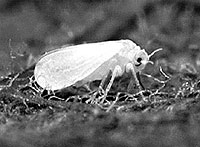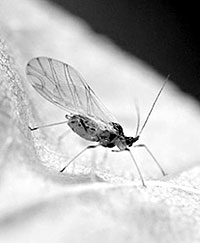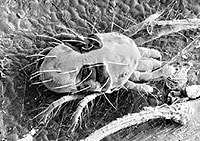By Colin D. Stewart, Ph.D., University of Maine Cooperative Extension Homeowner/Greenhouse IPM Specialist
This article discusses many lower toxicity pest control measures, including biological controls. The key to using biologicals successfully is to monitor your greenhouse regularly to detect and correctly identify pests and to introduce the correct biological control agent before large numbers of pests are present.
Sanitation and Screening
The best way to fight greenhouse pests is to prevent them entirely. Before starting a new crop, disinfect the entire greenhouse. Avoid keeping “pet plants,” because they may allow pests to carry over from one crop cycle to the next. Ideally, quarantine incoming plants for a few weeks before moving them where they will contact other crops. If this isn’t possible, examine incoming plants before bringing them into the greenhouse.
The last thing you want is to open a box of new plants and have a cloud of fungus gnats or other pests come out of the box and infest your other crops.
Pests frequently come in from weeds and other plants located near the greenhouse. Keeping a 10- to 20-foot-wide plant-free zone using weed cloth or mulch can greatly reduce the numbers of thrips, whiteflies, aphids and other pests. In fact, a Maine grower who had been raising perennials just outside the greenhouse reported that by moving the perennials to another location, he was able to reduce pesticide use inside the greenhouse for, he suspects, this very reason. Weeds inside a greenhouse can support large numbers of whiteflies, thrips, aphids and other pests, which then continually infest the crop. Removing potting mix and plant debris from benches and floors can reduce fungus gnats, shore flies and plant diseases. Another useful technique for reducing diseases is to keep hoses off the ground by hanging them on hooks when not in use.
Screening air intakes and doors can prevent airborne pests from entering the greenhouse – and can keep beneficial insects inside. While screening can be highly effective, it’s not as easy as simply putting a screen outside a vent. The screen can impede airflow and result in cooling problems if not done properly. More information on this topic can be obtained from the National Greenhouse Manufacturer’s Association at 1-800-792-NGMA or at www.ngma.com.
Horticultural oils and insecticidal soaps* are lower toxicity pesticides that can be used to kill aphids, mites, thrips, whiteflies and adult fungus gnats and thrips. They work on contact, so the key is getting good coverage, particularly on the underside of the leaf, where mites, immature whiteflies and other pests are often found. Avoid making applications to moisture-stressed plants, when temperatures may exceed 85 degrees, and to plants not appearing on the label, to reduce the chance of injuring the foliage.
 |
| A one-sixteenth-inch long Silverleaf whitefly, Bemisia argentifolii. Note the angle of the wings. Photo by Scott Bauer, courtesy of USDA Agricultural Service. |
Whiteflies
While heavy infestations of whiteflies, primarily the greenhouse whitefly and silverleaf whitefly, may lead to premature leaf drop, the primary reason that growers manage these pests is aesthetic: Clients object to the mere presence of whiteflies on their plants. Greenhouse whiteflies hold their wings nearly flat when at rest, while silverleaf whiteflies hold their wings at a sharp angle.
Parasitic wasps, Encarsia formosa and Eretmocerus eremicus, can be effective against greenhouse and silverleaf whitefly, respectively. These small wasps are harmless to humans. Eretmocerus is sold in containers with sawdust or bran, and both are sold on cards containing parasitized whiteflies. For best results, avoid getting the sawdust or bran wet. Neem oil, insecticidal soap and horticultural oil* are compatible with these wasps. While the predator Delphastus catalinae can kill large numbers of whiteflies, parasitic wasps are a more cost effective option (Smith, 2003). The beneficial fungus Beauvaria bassiana, sold under the trade name BotaniGard,* can be used on both species. Do not tank-mix this beneficial fungus with fungicides.
Aphids
Most growers are all too familiar with aphids, which distort leaves, produce objectionable honeydew as a waste product, and remove plant juices. Melon and green peach aphids, Aphis gossypii and Myzus persicae, respectively, are the most commonly encountered aphids in the greenhouse. Before beginning a biological control program, have the aphids that you are trying to manage identified.
 |
| An alate (winged) green peach aphid (Myzus persicae). Photo by Scott Bauer, courtesy of USDA Agricultural Research Service. |
Yellow sticky cards can be an effective monitoring tool. For aphids, though, it makes more sense to examine the entire plant or to perform beat samples over a white surface. Winged aphids appearing on cards are frequently either recent immigrants that flew in from outdoors or an indication that large numbers of aphids are present on your crop already and are preparing to disperse to other plants. While the aphids themselves are frequently camouflaged and difficult to see, their white shed skins often stand out. Large numbers of ants feeding on honeydew, a sugary waste product of aphids, can also indicate that aphids or soft scale insects may be present in your crop.
Avoid overfertilizing with nitrogen. Providing the plant with more nitrogen than it needs actually favors certain pests, such as aphids and spider mites, which have been shown to reproduce more quickly in this situation. The most commonly used aphid biological control against both the green peach and melon aphid is the parasitic wasp, Aphidius colemani. The female wasp injects her egg inside the aphid, and the young wasp completes its development, forming the characteristic tan, swollen, “aphid mummy.”
Even voracious predators, such as the predatory midge, Aphidoletes aphidimyza, and green lacewing and lady beetle larvae, may fail to reduce extremely high aphid populations. In that case, some growers may want to use Endeavor (pymetrozine; not for certified organic growers), an insecticide that clogs the mouthparts of aphids and whiteflies yet is compatible with biological controls. The pests take a few days to starve to death. Other options include neem oil, the fungus Beauvaria bassiana, and others.*
Thrips
The western flower thrips, often described as “the hyphen that moves” due to its small size (1/16″ or less) and shape, is one of the most serious greenhouse pests. Thrips feed on leaves and flowers causing discoloration and distortion. More importantly, however, one thrips can transmit impatiens necrotic spot virus (INSV) and tomato spotted wilt virus (TSWV) after feeding for only 30 minutes. Weed control is essential. Weeds, which may harbor both the thrips and viruses, may be infected with the viruses but not show symptoms.
Biological controls, such as the minute pirate bug and predatory mites (Amblyseius cucumeris, A. degenerans, and Hypoaspis miles), can reduce the number of thrips. However, growers with whom I have spoken have had limited success with them, as have I. One problem is that if TSWV or INSV are present, then the tolerance for thrips is zero, an unreasonable expectation for biological controls.
Conserve SC (spinosad) is providing excellent control of thrips on greenhouse ornamentals. Unfortunately, this formulation is not “organic” and the label specifically prohibits its use on vegetables and fruit trees. To “conserve” this highly effective tool, pay strict attention to the label, which states that this active ingredient may not be used more than three times in a row, more than 10 times per year on a given crop, OR more than 10 times per year in a greenhouse. Entrust, an organic product containing spinosad and approved for use on vegetables, is not yet approved for greenhouse use. I spoke with a technical representative and, as a result, he is now checking into the possibility of adding greenhouses and ornamentals to the label.
 |
| Scanning electron micrograph of a two-spotted spider mite feeding on a rose leaf. Magnified about 200X. Photo by Eric Erbe; courtesy of USDA Agricultural Research Service. |
Two-spotted Spider Mites
These tiny (1/50″ long) pests feed on the leaf underside, creating a stippled appearance, webbing and leaf drop. This “warm season” mite prefers warmer temperatures and can complete a generation in one week at 81 degrees F. Problems often arise first near walls, steam pipes, heaters and vents. Look for damage or shake the foliage over a white surface and look for movement.
Phytoseiulus persimilis is a commonly used predatory mite capable of consuming up to 20 immature two-spotted spider mites per day, so it is good for reducing larger populations of two-spotted spider mites. Another useful predatory mite, Neoseiulus californicus, takes longer than P. persimilis to reduce prey numbers but is better able to persist on, locate and manage low densities of spider mites. These species are also sold in combination to provide both short and longer-term control.
Keeping infested plants in close proximity will create “leaf bridges” and allow the predators to move from plant to plant. Misting the plants early in the morning may also increase predators’ effectiveness, but avoid misting in the evening due to potential problems with Botrytis, a common disease.
Fungus Gnats and Shore Flies
Fungus gnats feed on root tissue, and both flies feed on algae and fungi. Both also spread diseases, such as Pythium and Phytophthora. Shore flies have stout bodies and white spots on the wings, while fungus gnats do not. Both larvae are legless maggots. Unlike shore fly larvae, fungus gnat larvae have a black head capsule.
The best management tactics are basic sanitation and avoiding overwatering. Bacillus thuringiensis israelensis, sold under the trade name of Gnatrol,* can be effective when used as a soil drench against fungus gnat larvae. Typically one to three applications are required. Another option is the beneficial nematode, Steinernema feltiae, sold under the trade names of ScanMask and Nemasys.* This nematode enters the fungus gnat larva, releases bacteria that kill the larva in one to two days, completes multiple generations inside the larva, and leaves in search of a new host. Treat potting media and the soil under the benches. Unfortunately, neither of these organisms is effective against shore flies. A soil-dwelling, predatory mite, Hypoaspis miles, will feed on fungus gnat and shore fly larvae, provided the latter are not living in standing water. It needs to be released before fungus gnats and shore flies become serious problems.
Other lower toxicity options effective against fungus gnat larvae and shore flies include drenches with insect growth regulators such as neem oil (azadirachtin)*, and Distance (pyriproxifen; not for organic growers).
Resources
A free list of distributors of biologicals can be downloaded at: www.cdpr.ca.gov/docs/ipminov/bensuppl.htm or by calling (916) 324-4100 and asking for “Suppliers of Beneficial Organisms in North America,” by Charles D. Hunter.
Smith, T. “Insect and Mite Management.” New England Greenhouse Floriculture Guide; a Management Guide for Insects, Diseases, Weeds and Growth Regulators, 2003-2004. New England Floriculture. Pocasset, Massachusetts.
Contact me at [email protected] if you wish to receive the text of a talk describing how to monitor pests in the greenhouse or for other information. All pesticides are poisons. Always read the label before purchasing and applying a pesticide. Mention of a product or company does not imply endorsement either by University of Maine Cooperative Extension or by the author.
Colin D. Stewart, Ph.D., Homeowner/Greenhouse IPM Specialist, University of Maine Cooperative Extension, 491 College Ave., Orono, ME 04473-1295; (207) 581-2967 (Voice); (207) 581-3881 (FAX); [email protected]
* Certified growers need to check brand names with their local certifier to find out if particular products are approved for organic production. Most (but not all) certifiers go by the list at www.omri.org.
